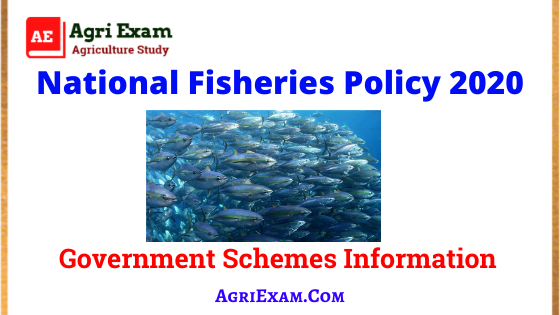National Fisheries Policy 2020

Introduction:-
Government of india has decided for introducing a comprehensive and integrated ‘National Fisheries Policy, 2020
This will be by integrating of National Fisheries Policy:
- National Policy on Marine Fisheries, 2017 (NPMF).
- Draft National Inland Fisheries and Aquaculture Policy (NIFAP)
- Draft National Mariculture Policy (NMP) .
NATIONAL FISHERIES POLICY 2020:-
- The Indian fisheries sector is set in a unique and diverse set of resource .
- It ranges from the pristine waters of the Himalayas to the sprawling Indian Ocean water.
The fisheries biodiversity of the country encompass a wide spectrum of physical and biological component that support the livelihood of million of people.
- With growing population and the increasing demand for fish protein, the need for sustainable development of aquatic resources is now felt much more than ever before.
FISHERIES MANAGEMENT STRUCTURE IN INDIA:-
- Fisheries being a State’s subject, the States play a pivotal role in fisheries governance.
- Inland Fisheries are fully managed by State’s Government.
Marine Fisheries are a shared responsibility between the Central and Coastal State/UT Governments.
- Coastal States/UTs are responsible for development and regulation of fisheries in the sea water inside the 12 nautical mile (22 km) territorial limit.
- Government of India is responsible for the development, management and regulation of fisheries in the EEZ waters beyond 12 nautical miles and up to 200 nautical miles (370 km).
CONSTRAINTS IN THE GROWTH OF FISHERIES SECTOR:-
- LIMITED SCOPE FOR EXPANSION.
- INADEQUATE INFRASTRUCTURE.
- INLAND FISHERIES
SPECIFIC PROBLEMS:-
- Low input culture system.
- Lack of diversity in culture practices.
- Increased incidents of disease.
- Low levels of investment.
VISION:-
- To develop an ecologically healthy, economically viable and socially inclusive fisheries sector.
- To provides food and nutritional security to the country in a sustainable and responsible manner.
MISSION:-
- Fisheries resources are to be developed, managed, regulated and conserved responsibly.
OBJECTIVES:-
- JUDICIOUS USE :- Optimally harness the capture and culture fisheries potential of the country by enhancing fish production and productivity in a responsible and sustainable manner.
- A ROBUST MANAGEMENT :- A regulatory framework with necessary legal backing for effective fisheries resource management through an Ecosystem Approach of Fisheries (EAF) management .
- VALUE CHAIN :- Strengthen and modernize value chain including creation of fisheries infrastructure to increase shelf life, reduction of post-harvest losses and production of value added products.
- INSTITUTIONAL CREDIT :- Access to institutional credit as priority lending on the lines of crop sector especially to small and marginal fishers and fish farmers and unemployed youth.
- FOOD SECURITY :- Ensure food and nutritional security by increasing the per capita availability of safe, affordable and quality fish.
STRATEGIES:-
- COMMITTEE :- A State level Inter-departmental Coordination Committee for Fisheries will be formed under the Chairmanship of the Agriculture Production Commissioner .
- FISHERIES MANAGEMENT PLANS :– The Centre will formulate ‘Fisheries Management Plans’ (FMPs) for scientific management and regulation of marine fisheries resources.
- INTEGRATED FISHERIES DEVELOPMENT PLAN :- The government will prepare and implement ‘Integrated Fisheries Development Plan’ for Islands to enhance the share in their economy.
- FISHERIES SPATIAL PLANS :- The State governments will prepare Fisheries Spatial Plans (MSP) with central government for data management, analysis, modelling and decision making.
- UPDATED ‘FISHERIES ACT’ :- In inland open waters preventing use of destructive gears, killing of juveniles and destructive fishing, etc., will be strictly adhered through enactment of updated ‘Fisheries Act’
INTERNATIONAL AGREEMENTS:–
- Indian fisheries are now set in a globalized world.
- The global agenda on fisheries is guided by a set of binding and non-binding instruments that concern both fisheries and environmental aspects.
The FAO’s Code of Conduct for Responsible Fisheries (CCRF or Code) is today the most significant of the non-binding agreements in the global fisheries sector.
MEASUREMENT OF IMPACT:-
- EXTENT OF INTERVENTIONS :- In terms of incentives and support measures envisaged in the in the policy.
- INVESTMENT :- Increase in the investment in different segments of supply chain and farming infrastructure.
- GVA :– Increase in output and contribution of fisheries sector in GVA.
- LOSSES :– Extent of reduction in post -harvest losses and spoilage.
- INCOME COMPARISON :- Better farm gate price to farmers enabling increase in farm incomes.
- EXPORTS :- Increase in export of sea food products.
Related MCQs:-
Q.1 When did National Fisheries Policy Introduced?
- 2017
- 2018
- 2019
- 2020
Q.2 What are the integrating of National Fisheries Policy?
- Limited Scope For Expansion.
- Inadequate Infrastructure.
- Inland Fisheries
- All The Above
Q.3 What are main Constraints in The Growth of Fisheries Sector?
- Limited Scope For Expansion.
- Inadequate Infrastructure.
- Inland Fisheries
- All the above
Q.4 Main objective of National Fisheries Mission?
- Judicious Use
- Institutional Credit
- Food Security
- All the above
Q.5 Full Form of CCRF?
| All Government Schemes | Click |
| Agriculture Study Material | Click |
Informative